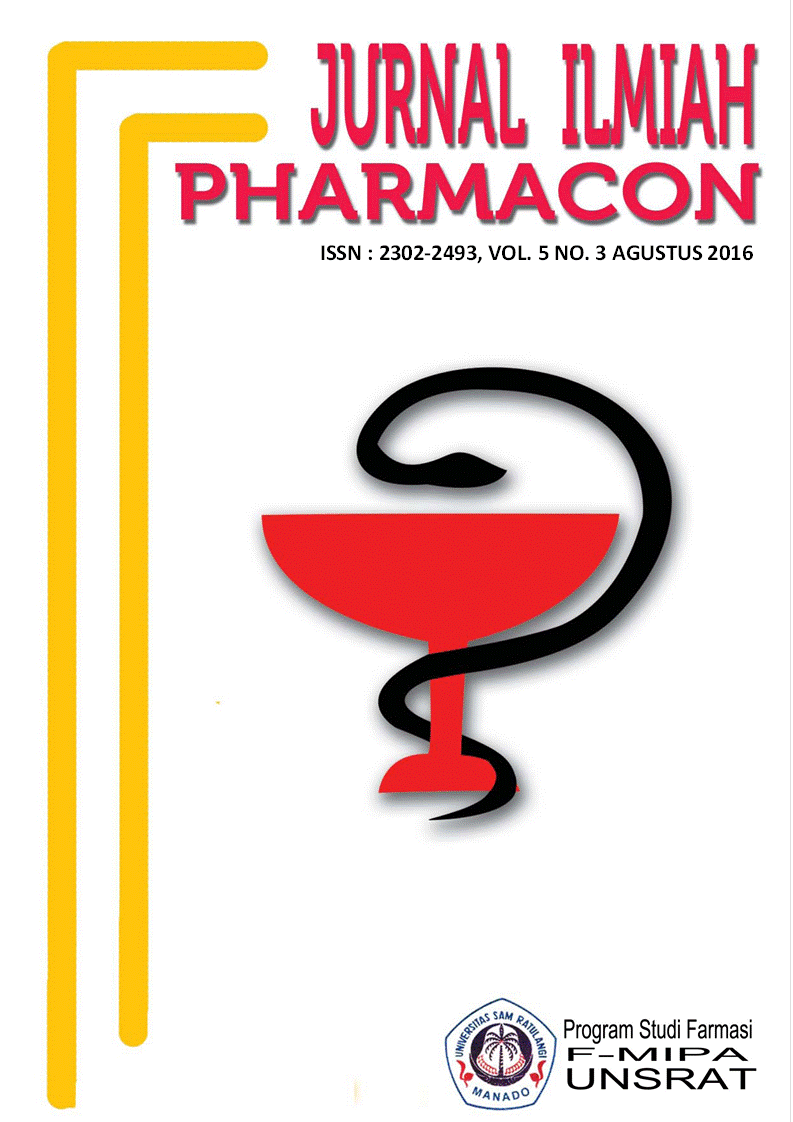IDENTIFIKASI SENYAWA FITOKIMIA DAN UJI TOKSISITAS DENGAN METODE BSLT EKSTRAK ETANOL BUNGA UBU-UBU (Hibiscus rosa-sinensis L.) DARI MALUKU UTARA
DOI:
https://doi.org/10.35799/pha.5.2016.12971Abstract
IDENTIFIKASI SENYAWA FITOKIMIA DAN UJI TOKSISITAS DENGAN METODE BSLT EKSTRAK ETANOL BUNGA UBU-UBU (Hibiscus rosa-sinensis L.) DARI MALUKU UTARA
Lievyana F. Tulangow1), Edwin De Queljoe2), Herny Simbala2)
1)Program Studi Farmasi, FMIPA, UNSRAT Manado, 95115
2)Jurusan Biologi, FMIPA UNSRAT Manado, 95115
Â
Â
ABSTRACT
Ubu-ubu flower (Hibiscus rosa-sinensis L.) is a medical plant which have the potential as anti-diabetes, anticonvulsant, cardioprotector and anti-inflamatory. This research aims to identify phytochemical content and to determine the toxicity value of Ubu-ubu flower ethanol extracts collected from Akehuda and Wayafli Village, North Maluku through toxicity test assessed using BSLT method. Extraction was done by ultrasonication method using ethanol 95% as the solvent. Phytochemical screening was done according to Harborne method including identification of flavonoids, alkaloids triterpenoids, steroids and tannins. BSLT method had been used in toxicity essay, shrimp larvae had been put in test solutions, each provided with different concentration. The observation was done every 60 minutes in 24 hours. The value of LC50 were obtained based from the calculation of shrimp larvae lethality percentage using probit analysis. The result of phytochemical screening showed that Ubu-ubu flowers ethanol extracts from Akehuda and Wayafli both containing phytochemical compounds namely flavonoids, triterpenoids and tannin. LC50 values were 76,913 ppm for Ubu-ubu flowers extracts from Akehuda and 71,779 ppm for Ubu-ubu flowers ethanol extract from Wayafli.
Keywords: Ubu-ubu (Hibiscus rosa-sinensis L.), Phytochemical Screening, Toxicity
Assay, Brine Shrimp.
Â
ABSTRAK
Bunga Ubu-ubu (Hibiscus rosa-sinensis L.) merupakan tanaman berkhasiat obat yang dapat digunakan sebagai antidiabetes, antikonvulsan, kardioprotektor dan antiinflamasi. Penelitian ini bertujuan untuk mengidentifikasi senyawa fitokimia dan menentukan nilai toksisitas ekstrak etanol bunga Ubu-ubu dari Maluku Utara yang diambil dari Desa Akehuda dan Desa Wayafli melalui uji toksisitas menggunakan metode BSLT. Ekstraksi dilakukan dengan metode Ultrasonikasi menggunakan pelarut etanol 95%. Pengujian senyawa fitokimia dilakukan dengan metode Harborne yang mencakup identifikasi flavonoid, alkaloid, triterpenoid, steroid dan tanin. Uji toksisitas dilakukan dengan menggunakan metode BSLT, larva udang yang masukkan dalam empat larutan uji dengan masing-masing konsentrasi larutan yang berbeda. Pengamatan dilakukan setiap 60 menit selama 24 jam. Nilai LC50 didapatkan berdasarkan perhitungan persen kematian larva udang menggunakan analisis probit. Hasil identifikasi fitokimia menunjukkan bahwa ekstrak etanol bunga Ubu-ubu Wayafli dan Akehuda mengandung flavonoid, triterpenoid dan tanin. Nilai LC50 yang diperoleh yaitu 76,913 ppm untuk ekstrak bunga Ubu-ubu dari Akehuda dan 71,779 ppm untuk ekstrak bunga Ubu-ubu dari Wayafli.
Â
Kata kunci: Ubu-ubu (Hibiscus rosa-sinensis L.), Identifikasi Fitokimia, Uji
Toksisitas, Larva Udang.
Â
Â
Downloads
Published
How to Cite
Issue
Section
License
Authors who publish with this journal agree to the following terms:
- Authors retain copyright and grant the journal right of first publication with the work simultaneously licensed under a Creative Commons Attribution-NonCommercial 4.0 International License that allows others to share the work with an acknowledgement of the work's authorship and initial publication in this journal.
- Authors are permitted and encouraged to post their work online (e.g., in institutional repositories or on their website) prior to and during the submission process, as it can lead to productive exchanges, as well as earlier and greater citation of published work (See The Effect of Open Access)










